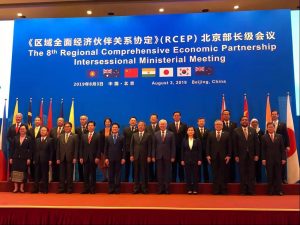The Regional Comprehensive Economic Partnership (RCEP) is set to be signed after eight years of “blood, sweat and tears,” conjuring into existence a free trade zone that will encompass a third of the global economy.
The RCEP mega-pact, which includes China but not the United States, was finalized in a virtual ministerial meeting on November 11 and will be signed on the final day of the 37th ASEAN Summit on November 15. The signatories to the trade deal – which unites the 10 nations of ASEAN plus Japan, China, South Korea, Australia, and New Zealand – have also left the door open for India, which withdrew from the RCEP negotiations earlier this year, due to concerns about the impact on local producers.
“All RCEP participating countries have concluded negotiations and will sign the RCEP agreement this Sunday,” Mohamed Azmin Ali, Malaysia’s international trade and industry minister, said in a statement following the ministerial meeting. “After eight years of negotiating with blood, sweat and tears, we have finally come to the moment where we will seal the RCEP Agreement.”
While some observers have questioned RCEP’s likely cohesiveness, its creation will leave the U.S. languishing outside the two major existing Asian trade agreements, even as it seeks to counter and neutralize China’s ambitions in Asia.
In January 2017, three days into his presidency, President Donald Trump withdrew the U.S. from the Trans-Pacific Partnership (TPP), a 12-nation trade deal that was painstakingly shepherded across the line by the Obama administration. Kurt Campbell, who served as assistant secretary of state for East Asian and Pacific affairs under Obama, described the TPP as the “true sine qua non” of Obama’s “pivot to Asia” policy.
The 11 other TPP signatories have pushed forward with the pact, now known as the Comprehensive and Progressive Trans-Pacific Partnership (CPTPP). While they would welcome the incoming Biden administration rejoining the deal, this is unlikely given the prevailing skepticism about free trade deals on all sides of U.S. political dial.
Although the U.S. retains a significant edge in military power, and remains a crucial economic partner to many Asian nations, the present administration has neglected the economic dimensions of its competition with China. As I’ve noted before, its tendency of picking small-bore trade disputes with regional partners has only undermined its broader goal of countering China’s influence in the region. Ankit Panda, a former editor at The Diplomat, wrote on Twitter that the imminent signing of RCEP was “a reminder that big things are happening – and will continue to happen – in Asia, with or without the United States.
While the strategic impact is unlikely to be felt immediately, the long-term ramifications could be profound. In the mid-twentieth century, the U.S. setting of international standards – on everything from trade rules and industrial standards to the angle of screw threads and shape of traffic signs – was a crucial and often underestimated pillar of American global power. But according to Evan Feigenbaum of the Carnegie Endowment for International Peace, the U.S. now sits outside the two agreements “that will set trade and investment standards in Asia for a generation.”
The RCEP deal is set to be signed on the final day of the 37th ASEAN Summit, which will run from November 12-15. The summit – and its surrounding galaxy of meetings, ASEAN+1 conclaves, and talk-shops – is being conducted via video link due to the ongoing pandemic. Also high on the crowded summit agenda will be recovery from the COVID-19 pandemic and the ongoing humanitarian crisis in Myanmar’s Rakhine State.

































